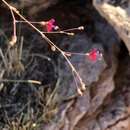Comments
(
Inglês
)
fornecido por eFloras
The phase Boerhavia gracillima subsp. decalvata from low elevations in the Big Bend region of Texas and adjacent Mexico differs from the remainder of B. gracillima in that it is usually erect or strongly ascending, has glabrous fruits, and has flowers with purple to brick red perianths; the flowers are also in the upper half of the size range for the species. It is highly local and completely intergradient with surrounding populations of B. gracillima in the strict sense. In fruit and flower features the phase resembles B. anisophylla; in its diffuse inflorescence with slender branches (0.15 mm diam. proximal to the flower versus 0.25 mm in B. anisophylla) and in its deciduous bracts it is more similar to B. gracillima. Some populations of B. gracillima also have glabrous fruits, and a local endemic in Durango, B. chrysantha Barneby, differs primarily in its yellow perianths similar in size to those of B. gracillima subsp. decalvata. The complex is in need of careful study.
- licença
- cc-by-nc-sa-3.0
- direitos autorais
- Missouri Botanical Garden, 4344 Shaw Boulevard, St. Louis, MO, 63110 USA
Description
(
Inglês
)
fornecido por eFloras
Herbs, perennial, often woody at base; taproot long and ropelike, woody. Stems decumbent to erect, usually profusely branched throughout, 2-15 dm, usually minutely pubescent, rarely glabrous basally, usually glabrous, rarely sparsely and minutely pubescent distally. Leaves mostly in basal 1/2 of plant; larger leaves with petiole 3-25 mm, blade broadly rhombic to elliptic-oblong, broadly to narrowly ovate, occasionally wider than long, 18-45 × 13-50 mm (distal leaves smaller, proportionately narrower), adaxial surface glabrous, abaxial surface much paler than adaxial surface, glabrous or with hairs on veins, neither surface punctate, base usually obtuse to round, sometimes shallowly cordate, margins entire or sinuate, often undulate, apex acute, obtuse, or round. Inflorescences axillary or terminal, forked ca. 6-8 times unequally, diffuse, without sticky internodal bands; branches divergent, terminating in 1(-3) flowers. Flowers: pedicel slender, 3-13 mm; bracts at base of perianth quickly deciduous, 2-3, linear-lanceolate to broadly lanceolate, 0.3-1.5 mm, quickly deciduous; perianth wine red to brick red, widely funnelform distal to constriction, 2-4.5 mm; stamens (4-)5(-6), well exserted. Fruits usually borne singly, gray-brown to brown, oblong-clavate, 2.8-4.2 × 1-1.5 mm (l/w: [2-]2.2-3.5[-3.8]), apex round to rounded-conic, minutely puberulent, sometimes minutely glandular, rarely glabrous; ribs 5, rounded, smooth or slightly rugose near sulci; sulci 1-2.5 times as wide as base of ribs, not rugose, smooth or minutely papillate.
- licença
- cc-by-nc-sa-3.0
- direitos autorais
- Missouri Botanical Garden, 4344 Shaw Boulevard, St. Louis, MO, 63110 USA
Distribution
(
Inglês
)
fornecido por eFloras
Ariz., N.Mex., Tex.; Mexico.
- licença
- cc-by-nc-sa-3.0
- direitos autorais
- Missouri Botanical Garden, 4344 Shaw Boulevard, St. Louis, MO, 63110 USA
Flowering/Fruiting
(
Inglês
)
fornecido por eFloras
Flowering mid summer-late fall.
- licença
- cc-by-nc-sa-3.0
- direitos autorais
- Missouri Botanical Garden, 4344 Shaw Boulevard, St. Louis, MO, 63110 USA
Habitat
(
Inglês
)
fornecido por eFloras
Dry, usually rocky areas, often along roads, desert scrub, arid grasslands, pinyon-juniper woodlands [tropical deciduous forests]; [100-]600-2000m.
- licença
- cc-by-nc-sa-3.0
- direitos autorais
- Missouri Botanical Garden, 4344 Shaw Boulevard, St. Louis, MO, 63110 USA
Synonym
(
Inglês
)
fornecido por eFloras
Boerhavia gracillima subsp. decalvata Heimerl ex Standley; B. organensis Standley
- licença
- cc-by-nc-sa-3.0
- direitos autorais
- Missouri Botanical Garden, 4344 Shaw Boulevard, St. Louis, MO, 63110 USA
Boerhavia gracillima
(
Inglês
)
fornecido por wikipedia EN
Boerhavia gracillima, the slimstalk spiderling, is a plant species native to Arizona, New Mexico, Texas and Mexico. It prefers dry, rocky areas such as grasslands, desert scrub, roadsides and pinyon-juniper woodlands.[4][5]
Boerhavia gracillima is a perennial herb, often woody at the base. Stems are trailing to erect, with many branches. Leaves are mostly on the lower half of the plant, getting smaller further up. Flowers are red, clustered in the axils of the leaves or at the tips of the stems, each flower up to 4.5 mm (0.2 inches) long.[6][7][8]
References
-
^ "NatureServe Explorer 2.0". explorer.natureserve.org. Retrieved 1 April 2023.
-
^ Tropicos
-
^ The Plant List
-
^ Flora of North America v 4 p 21.
-
^ CONABIO. 2009. Catálogo taxonómico de especies de México. 1. In Capital Nat. México. CONABIO, Mexico City.
-
^ Heimerl, Anton. Botanische Jahrbücher für Systematik, Pflanzengeschichte und Pflanzengeographie 11(1): 86–87, pl. 2, f. 1. 1889.
-
^ Correll, D. S. & M. C. Johnston. 1970. Manual of the Vascular Plants of Texas i–xv, 1–1881. The University of Texas at Dallas, Richardson.
-
^ Shreve, F. & I. L. Wiggins. 1964. Vegetation and Flora of the Sonoran Desert 2 vols. Stanford University Press, Stanford.

- licença
- cc-by-sa-3.0
- direitos autorais
- Wikipedia authors and editors
Boerhavia gracillima: Brief Summary
(
Inglês
)
fornecido por wikipedia EN
Boerhavia gracillima, the slimstalk spiderling, is a plant species native to Arizona, New Mexico, Texas and Mexico. It prefers dry, rocky areas such as grasslands, desert scrub, roadsides and pinyon-juniper woodlands.
Boerhavia gracillima is a perennial herb, often woody at the base. Stems are trailing to erect, with many branches. Leaves are mostly on the lower half of the plant, getting smaller further up. Flowers are red, clustered in the axils of the leaves or at the tips of the stems, each flower up to 4.5 mm (0.2 inches) long.
- licença
- cc-by-sa-3.0
- direitos autorais
- Wikipedia authors and editors

